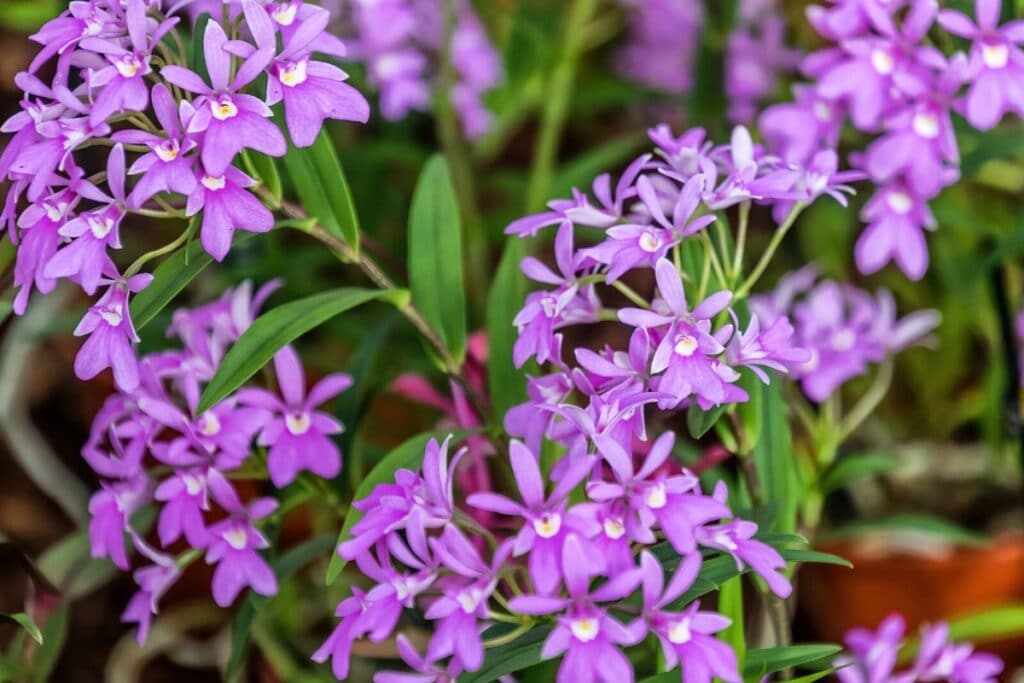Orchids always make an exciting addition to any home garden, thanks to their unusual yet beautiful, often fragrant blooms and easy to care nature. If you are thinking of incorporating one in your plant collection, one type to consider is epidendrums orchids.
Epidendrum orchids are highly popular house plants that offer home gardeners with tons of variety in colors, forms, and sizes.
Read on below our comprehensive guide about these beautiful ornamental plants and learn about their facts, popular species, as well as growing and caring tips.
Facts About Epidendrum Orchids
General Plant Description
Epidendrum (Epidendrum spp.) is a broad genus of orchids with over 1,500 known species. They are also known as star orchids, crucifix orchids, and reed orchids. The name epidendrum originated from the Greek words epi and dendron, which translates to “upon trees,” referring to the plants’ growth habit.
Most species of epidendrum orchids are epiphytic, typically growing on trees. However, some of them are terrestrial and thrive on low nutrient growing media. Because of their diverse nature, you can find different forms of epidendrums.
Some species produce pseudobulbs, while others have cane-like stems. The flowers’ colors and shapes also vary depending on the epidendrum orchid varieties. Moreover, members of the Epidendrum genus can be unifoliate with a few shoots or bifoliate with densely arranged leaves.
One distinct common feature of most epidendrum orchids is their three-lobed lip that closes in on the center. Flowers in varying colors, including purple, white, yellow, and red, grow in clusters on long flower spikes. Each bloom typically measures about 1 inch in diameter (1). Each flower cluster usually has 30 to 40 long-lasting blooms.
Types of Epidendrum Orchids
There are two main classifications of epidendrum orchids, according to Elvin Mcdonald’s Ortho’s All About Orchids. These are epidendrums with reed stems and epidendrums with pseudobulbs.
Epidendrum orchids with reed stems are epidendrums that showcase attractive flowers regularly. For that reason, they are often a favorite of many orchid enthusiasts as they make excellent cut flowers. One thing to remember, though, is that these orchids can grow tall and may not be ideal as indoor houseplants. Examples include E. ibaguense and E. cinnabarimum.
Epidendrums with pseudobulbs, on the other hand, are epidendrum orchids that must be kept moist during flowering. Then, they go dormant for a few weeks after they bloomed. Species that are part of this classification are E. radicans and E. obrienanum.
Popular Epidendrum Orchid Species to Grow in Your Garden
Crucifix Orchid (Epidendrum ibaguense)
Crucifix orchids, otherwise known as Epidendrum ibaguense, is one of the most popular species of epidendrum orchids. They are naturally found in Brazil, Venezuela, Colombia, French Guiana, and Trinidad.
This type of epidendrum orchids features long, thin stems, leathery leaves, and long-lasting flowers. The plant reaches up to 1m in height as an epiphytic or terrestrial type of orchids. The flowers are small, measuring about 2.5 cm to 4 cm in diameter, and can be orange, red, or yellow. The lip features fringe-like edges.
Another common name of this Epidendrum species is Reed-Stemmed Orchids.
Fire Star Orchid (Epidendrum radicans)
E. radicans, more popularly known as Fire Star Orchid, Rainbow Orchid, Reed-Stem Orchid, and Ground-Rooting Epidendrum, is another famed epidendrum species commonly grown as houseplants. They are native to Mexico (2) and can be found throughout Central America.
One distinctive feature of this plant is that it tends to grow roots all along the length of its stems, unlike most plants in the genus. Though they are widespread as weeds in their natural range, these plants thrive well when grown in pots both indoors and outdoors.
The fire star orchids bloom between fall and spring on long flower stalks that reach up to 38 inches in length. The flowers are typically red-orange with hints of yellow throats, while the leaves are oval and leathery.
Stamford’s Epidendrum (Epidendrum stamfordianum)
Stamford’s Epidendrum orchids (E. stamfordianum) is a medium-sized epiphytic species of epidendrums that can be found throughout South Mexico to Venezuela (3). This species was named after Mr. Stamford, an English orchid enthusiast during the 1800s.
Stamford’s epidendrums prefer bright lights, warm conditions, and drying periods between watering. They feature upright pseudobulbs where three to four oblong and leathery leaves emerge. The flowers of this epidendrum orchid are fragrant and measure about 1.5 inches each. They bloom in winter, spring, and summer.
Two of the most popular varieties include Epidendrum stamfordianum var. album and Epidendrum stamfordianum var roseum. The album variety has green petals, green sepals, and white and yellow lip. The roseum variety, on the other hand, has petals and sepals that are green with red spots, and a noticeable pink lip.
Lopsided Star Orchid (Epidendrum secundum)
E. secundum, more commonly known as Lopsided Star Orchid or Angel Orchid, is another type of crucifix orchid. The plant grows naturally in parts of Colombia, Peru, Venezuela, Ecuador, and Brazil at elevations between 600 to 3200 meters. It blooms beautifully at any time of the year, with flowers measuring up to 1.2 cm wide each.
Night Scented Orchid (Epidendrum nocturnum)
This epidendrum orchid occurs in the West Indies, Bahamas, and Central America, but is most common in South Florida. Also called the Nocturnal Epidendrum, the Night Scented Orchid or E. nocturnum flaunts beautiful blooms that are fragrant at night but usually don’t open; hence the name.
These epidendrum orchids have terete stems and narrow elliptic leaves. The flowers, which are capable of self-pollination, feature long and slender petals and sepals, and three-lobed white lip at the center.
Growing Epidendrum Orchids
Growing epidendrum orchids is almost as easy as the other orchid types. You may think it’s a handful, but once you’ve learned the basics, then you’re good to go! In case you’ve no idea about the necessary growing and caring requirements of these fascinating blooms, here’s some info to help you get started.
Light
When cultivating Epidendrums, it’s essential to consider their natural habitat and provide the right light conditions.
Epidendrums prefer indirect medium to bright light conditions. One indication that your orchid plant is receiving a sufficient amount of light is the grassy green foliage. If the leaves are turning brown, it only means that the plant is getting too much light. Insufficient light conditions, on the other hand, often result in reduced producing flowers.
Cutting off the spent flower stems would help your epidendrum plants to bloom again in two months.
Temperature
The required temperature epidendrum orchids varies depending on the species. Though, most epidendrums prefer warm tropical climates but tolerate lower temperatures of up to about 50 degrees F (10 degrees C) though flower production may be negatively affected at this temperature.
These plants prefer daytime temperatures between 65 degrees F to 75 degrees F (18 degrees C to 24 degrees C) and nighttime temperatures between 55 degrees F to 60 degrees F (13 degrees C to 16 degrees C).
Humidity
The ideal humidity level for growing epidendrum orchids can be anywhere between 50% to 70%.
Water
For epidendrums to remain healthy, watering should be done regularly. These orchids prefer to have their roots completely dried out between watering. During warmer months, a 4-day or 5-day interval between watering or at least once a week watering is ideal.
Water your orchid plants every morning, so the leaves are dry by night time.
Fertilizer
Though epidendrum orchid care is minimal, feeding your plants with fertilizers is still beneficial. Use a balanced fertilizer (20-20-20) at a half-strength dose once a week, preferably every time you water, or every two weeks.
Potting and Growing Media
As with other orchid types, epidendrums prefer good drainage. They are tolerant of low nutrient growing sites and can thrive well on bark or pots with orchid growing media. You can also use firk bark since it has good drainage and air circulation.
Moist sphagnum moss is a popular bedding for transplanted plants. Repotting is not required. However, it might be done every three years or so to replenish the potting soil. Repot in a bigger pot or container
FAQs
How often do epidendrum orchids bloom?
Epidendrum orchids typically bloom once or twice a year, although this can vary depending on the specific species or cultivar, growing conditions, and care provided.
Can you grow epidendrum indoors?
Yes, Epidendrum orchids can be grown indoors, especially in areas where outdoor cultivation is not feasible due to climate or space constraints. Providing them with bright, indirect light and proper air circulation is essential for successful indoor growth.
How often do you water epidendrum orchids?
Watering frequency for Epidendrum orchids depends on factors such as temperature, humidity, and potting medium. In general, water them when the top inch of the potting mix feels dry, typically every 7-10 days. Adjust watering frequency based on environmental conditions to prevent overwatering or underwatering.
References
Reference list
- Web.extension.illinois.edu. (2020). Growing Orchids. [online] Available at: https://web.extension.illinois.edu/hortihints/0204d.html
- ITIS Standard Report Page: Epidendrum radicans (2020). Available at: https://www.itis.gov/servlet/SingleRpt/SingleRpt?search_topic=TSN&search_value=565166#null
- Epidendrum stamfordianum (2020). Available at: https://www.si.edu/object/ofeo-sg_2008-0591A
Close
*Photo by PantherMediaSeller/depositphotos







